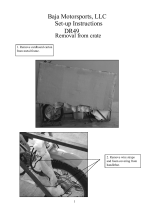
14 PREPA
RATION
WARNING
Never reuse old brake fluid.
Do not use fluid from a container that
has bee
n left unsealed or that has been
open for a long time.
Do not mix two types of fluid for use in
the bra
kes. This lowers the brake fluid
boiling point and could reduce brake ef-
fectiveness. It may also cause the rub-
ber br
ake parts to deteriorate.
Don’t leave the reservoir cap off for any
length of time to prevent moisture con-
tamin
ation of the fluid.
Don’t add or change brake fluid in the
rain or during conditions of blowing dust
or deb
ris.
CAUTION
Brake fluid quickly ruins painted sur-
faces. Wipe up any spilled fluid immedi-
atel
y.
•
Operate the brake lever several times.
•
If it feels spongy, there might be air in the
brake line.
•
If necessary, bleed the air in the front brake
lines.
•
Also check for fluid leakage around the fit-
tings.
Front Brake Line Air Bleeding
•
Re
move the reservoir cap and diaphragm,
and check that there is plenty of fluid in the
reservoir.
NOTE
The fluid level must be checked several times,
during the bleeding operation and replenished
as necessary. If the fluid in the reservoir runs
completely out any time during bleeding, the
bleeding operation must be repeated from the
beginning since air will have entered the line.
•
Attach a clear plastic hose to the bleed valve
on each front brake caliper and run the other
end of the hose into a container.
•
With the reservoir cap off, slowly pump the
brake lever several times until no air bubbles
can be seen rising up through the fluid from
the holes at the bottom of the reservoir. This
bleeds the air from the brake master cylinder
end of the line.
•
Pump the brake lever a few times until it
becomes hard and then, holding the lever
squeezed, quickly open (turn counterclock-
wise) and close the bleed valve. Then release
the lever. Repeat this operation until no more
air can be seen coming out into the plastic
hose.
A. Hold the brake lever applied.
B. Quickly open and close the bleed valve.
C. Release the brake lever.
•
Repeat the previous step one more time for
the other front disc brake.
•
When air bleeding is finished, check that the
fluid level is between the upper and lower
level lines.
•
Install the diaphragm and reservoir cap.
•
Tighten the bleed valves to the specified
torque.
Torque: 7.8 N·m (0.80 kgf·m, 69 in·lb)
•
Apply the brake forcefully for a few seconds,
and check for fluid leakage around the fittings.
Rear Brake Fluid
Rear Brake Fluid Level Inspection
•
With the rear brake fluid reservoir held hor-
izontal, check that the fluid level is between
the upper and lower level lines.






















